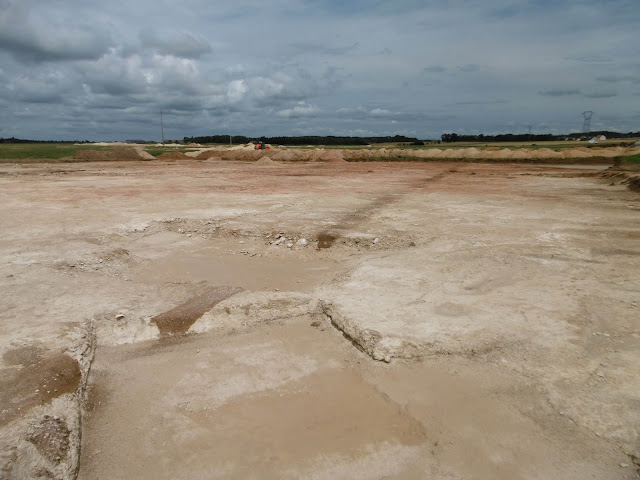 |
Artefacts found on the site.
|
Many of you will be familiar with the Journées Européenes du Patrimoine (European Heritage Open Days), but like us, you may not have heard of the Journées Européenes de l'Archeologie. I found out about them this year because a friend sent me a link. Apparently they've only been going a few years, and are an initiative of INRAP, the French national archaeology service.
 |
One end of the dig site, clearly showing the shallow boundry ditch of the 1st century agricultural area.
|
The European Archaeology Open Days were 18-20 June and in our area INRAP and the départementale (county) archaeology service offered visits to their joint site at the extension to the industrial zone that is being constructed near Sublaines. We've been curious to find out what discoveries have been made there for a while, so I immediately booked our time slot.
 |
An archaeologist indicates the big boundary ditch around the dwelling and workshop area.
|
The archaeology team were extremely welcoming and friendly, and very organised. While we waited for our turn to go onto the dig site we got to chat to a couple of them and to look at the artefacts found.
 |
Rectangular stone cellar with entry steps being indicated by an archaeologist. Lifting the stone building rubble to see what is underneath was one of the next tasks the archaeologists were planning.
|
The site is a 1st century gallo-roman farm, with the animal compound and cultivated area surrounded by a shallow ditch, and the dwelling and food storage area surrounded by a deep wide ditch and bank. The archaeologist who took us around explained that the deep ditch and bank were not really for defense or protection, but for prestige. The bigger and more impressive your ditch and bank, the higher the status you were demonstrating.
 |
Square stone cellar with walls topped by terracotta tiles. This one has no steps so the archaeologists conjecture that it was accessed by a wooden ladder.
|
The archaeological layer is not deeply buried. The vegetative layer has been removed and immediately the diggers were on to archaeology. The team has three more weeks to finish the work, then construction will start.
 |
An 10-11th century medieval lime kiln shows a later stage of industrial activity after the site shows no signs of human activity for centuries after the 1st century occupation.
|
When we visited it had rained very heavily during the night and obscured some of the changes in the soil that is often the only sign left of a building. The first thing we looked at were post holes, filled with dark soil in the surrounding pale limestone clay soil, and believed to be the remains of an animal shelter or workshop. We could clearly see the ditches too, but no trace of the house itself has been found. They know it must have been there though, because of the ditches and because of the underground storage spaces. The thought is that the site shows the transition between Gaulish building practices in wood and Roman building practices in stone. The site seems to have been established early in the 1st century, and by the end of that century the buildings were abandoned. However, there is a Roman villa fairly nearby, and the archaeologists think it is not inconceivable that the occupants of the site currently being dug were comfortable enough to have relocated and built somewhere grander. The site indicates the occupants farmed at least a hectare of land. If they had even as little as ten hectares in total they would have been rich, not just comfortable.
 |
Grain silo dug into the limestone. Two of these have been found and there may be others. The openings are narrower than the sides for ease of sealing them hermetically to preserve the grain.
|
 |
The dig site and the wider landscape. You can clearly see a change in soil type, from dark loam on the left, to pale limestone clay on the right.
|









2 comments:
"The bigger and more impressive your ditch and bank, the higher the status you were demonstrating."
Rather like a chateau, really!!
When you begin to dig, you have no idea what you'll find!
Post a Comment